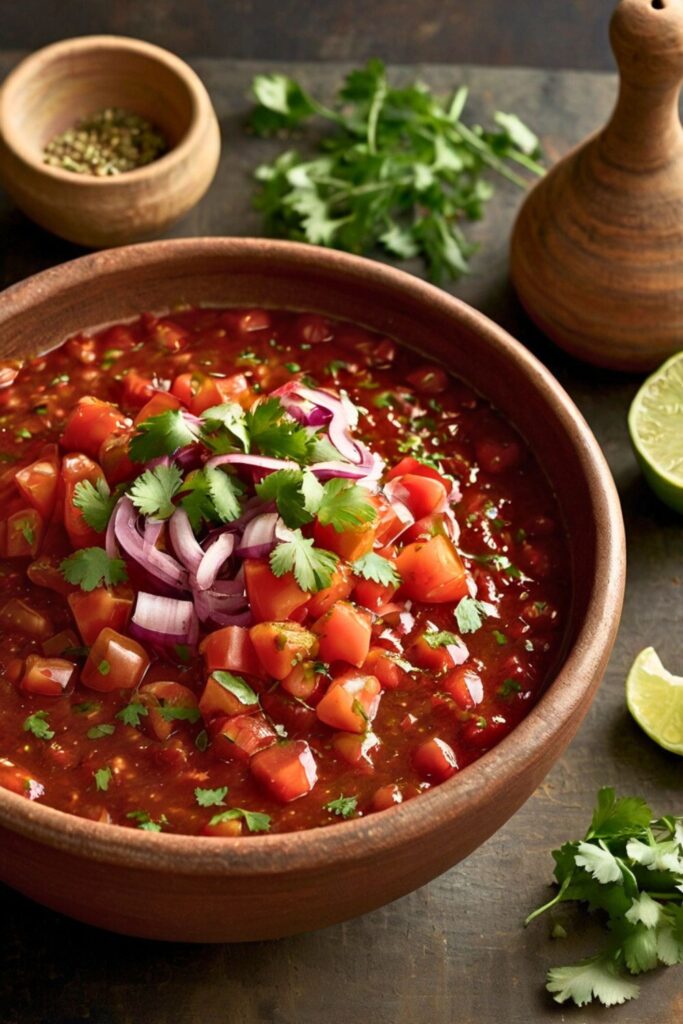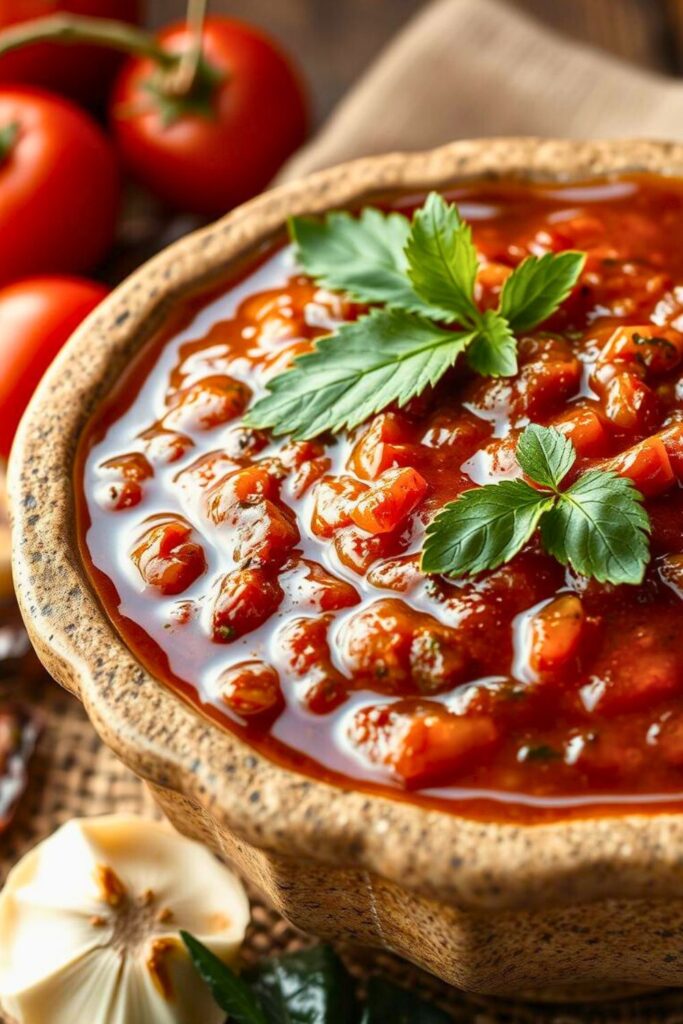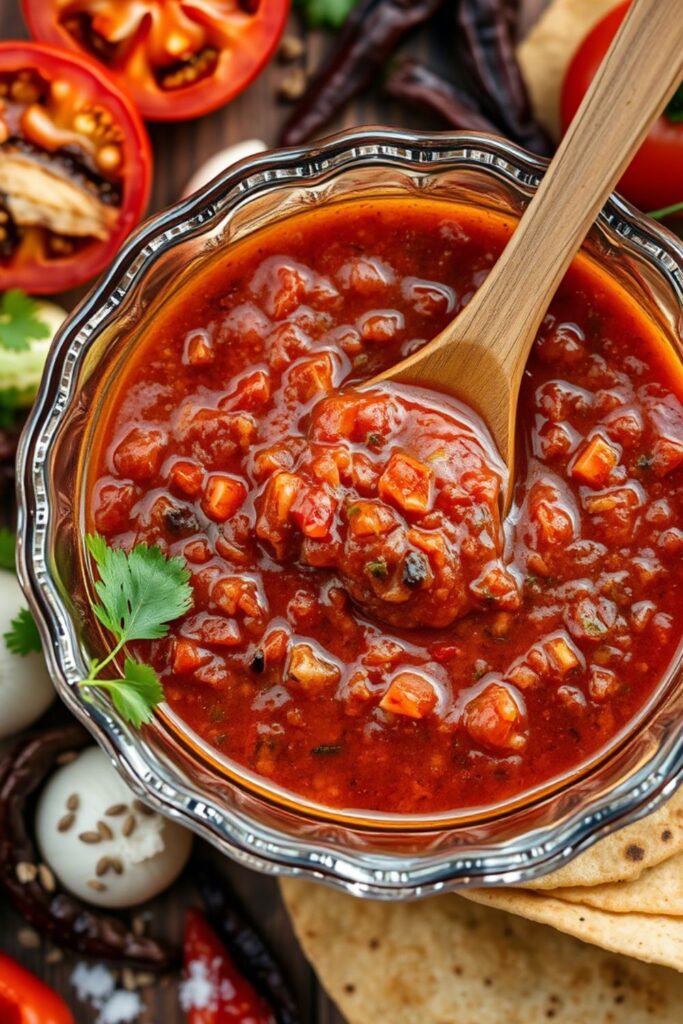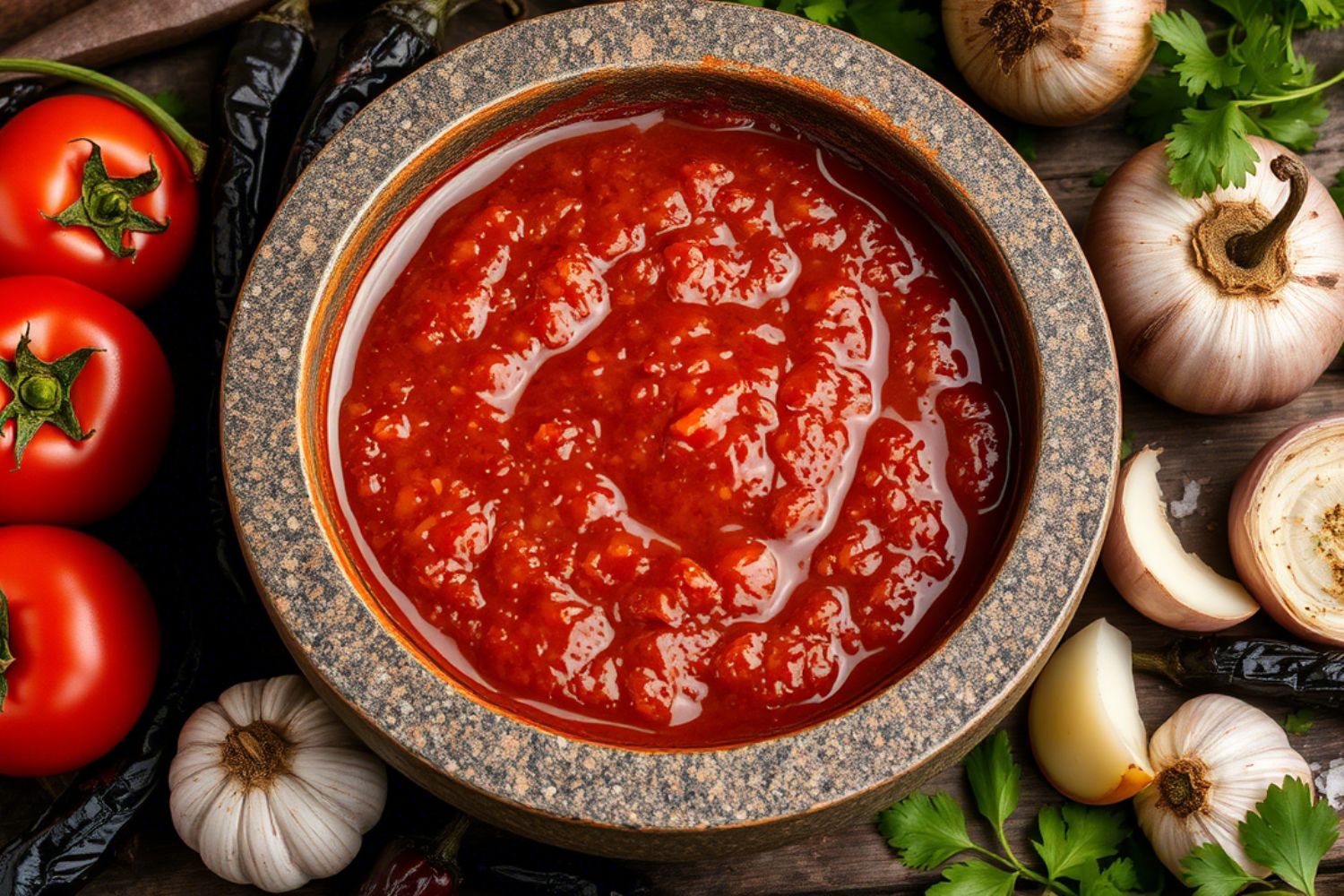Salsa Ranchera is bold, rustic, and built on fire kissed flavor. It’s a staple in Mexican kitchens—simple in ingredients, but layered in personality. What makes it special isn’t just the heat from the chiles or the smokiness from the char, it’s the freedom it offers. There’s no one way to make it right, only your way to make it yours.
This recipe doesn’t require fancy tools or specialty shops. Whether you’re working with a blazing comal or a hot cast iron pan, it’s all about coaxing deep flavor from humble ingredients. Don’t worry if you’re missing something, this salsa welcomes creativity. We’ll cover all the smart ingredient swaps soon, but for now, just know: Salsa Ranchera is forgiving, soulful, and wildly satisfying.
Grab your tomatoes, fire up your skillet, and get ready for something special. Let’s make magic from the simplest things.
Salsa Ranchera Ingredients & Smart Swaps

Here’s what you’ll need, listed in the order they hit the pan, no guessing or scrolling back mid cook. I’ve also included flexible swaps to help you adapt without losing flavor.
For the Base:
- 6 large Roma tomatoes (about 2 pounds)
- 3-4 jalapeño peppers
- 2 serrano chiles (optional, but recommended)
- 1 small white onion, quartered
- 4 garlic cloves, unpeeled
For Finishing:
- 1 teaspoon kosher salt (start with this, add more to taste)
- 1/2 teaspoon cumin
- 1/4 cup fresh cilantro, chopped
- 2 tablespoons lime juice
Now, let’s talk swaps because not everyone’s got a Mexican market down the street.
Can’t find serranos? Double up on the jalapeños, or throw in a couple of those little Thai bird chiles if you’re feeling brave. Roma tomatoes are ideal because they’ve got less water content, but regular tomatoes work fine, just cook them a bit longer.
White onion is traditional, but yellow onion won’t hurt anybody’s feelings. The key is using something with a sharp bite that’ll mellow beautifully when charred.
Here’s a pro tip about picking your chiles: look for ones that feel firm and have smooth, glossy skin. Wrinkled chiles are past their prime and won’t give you that fresh heat we’re after.
Don’t stress about perfection, this salsa is forgiving and full of soul. With a little fire and heart, you’ll make it yours.
Salsa Ranchera Step by Step Magic

Step 1: Fire Up Your Pan
Get a large cast iron skillet or comal screaming hot. We’re talking medium high heat here. No oil needed, we want direct contact between the ingredients and that hot metal.
This is where the magic starts happening. That char we’re gonna build adds a smoky depth that you simply can’t get any other way. It’s the heart of Salsa Ranchera, transforming simple ingredients into something bold, rustic, and unforgettable. Let the crackle and sizzle guide you, it means flavor is on the way.
Step 2: Char Those Tomatoes
Place your tomatoes in the hot pan and let them sit. Don’t move them around, patience is everything here. You want dark, almost black spots developing on the skin.
Turn them every 3-4 minutes until they’re charred all over and starting to collapse. The skin might split and that’s perfect. Those juices mixing with the char? Pure gold.
This whole process takes about 12-15 minutes, and your kitchen’s gonna smell incredible.
Step 3: Get Those Chiles Going
While the tomatoes are doing their thing, toss in your jalapeños and serranos. They’ll char faster than the tomatoes, so keep an eye on them.
You want them blistered and blackened in spots, but not completely burnt. About 6-8 minutes should do it. The skin should be easy to peel off, but honestly? Some of that charred skin adds flavor, so don’t stress about getting every bit.
Step 4: Onion and Garlic Time
Add your onion quarters to the pan. They need about 8-10 minutes to get those beautiful caramelized edges. The sugars in the onion are concentrating and sweetening as they char.
Garlic goes in for the last 3-4 minutes. Keep those cloves in their skins, it protects them from burning while they roast.
Step 5: The Blending Magic
Let everything cool for a few minutes, then peel that roasted garlic. It should slip right out of its skin.
Here’s where you’ve got options. Traditional method? Use a molcajete and grind everything by hand. It gives you better texture control and somehow tastes more authentic.
But your blender works great too. Start with the garlic and onion, pulse a few times, then add your chiles. Finally, add those beautiful charred tomatoes.
Don’t over blend! You want some texture here, not baby food. Think chunky salsa, not smooth sauce.
Step 6: Season Like a Pro
Add your salt, cumin, and lime juice. Taste and adjust, this is where your personal preference comes in.
Too mild? Add more chiles next time or leave some seeds in. Too hot? A tiny pinch of sugar balances the heat without making it sweet. Not enough depth? You might need more char next time.
Stir in that fresh cilantro right at the end. It adds brightness that cuts through all that smoky richness.
The Science Behind the Sizzle
Here’s what’s actually happening when we char those vegetables. High heat breaks down cell walls, concentrating flavors. It creates new compounds through the Maillard reaction. That’s the same process that makes steak taste amazing when you sear it properly.
The char isn’t just for show, it’s creating hundreds of new flavor compounds that simply don’t exist in raw vegetables. That’s why roasted tomatoes taste so much more complex than fresh ones, it’s also the secret behind a deeply flavorful Salsa Ranchera.
Chiles are particularly interesting. Cooking concentrates capsaicin by removing water. But char adds bitter and smoky notes that balance heat, which is essential for crafting the bold taste of traditional Salsa Ranchera.
Mexican cooks have used this technique for centuries. Before blenders, cooks charred vegetables then ground them on molcajetes. The stone’s rough surface breaks down ingredients without creating smooth purees.
That’s why I always say: if you’ve got a molcajete, use it. The texture is just different, more rustic, more interesting.
Wrapping It Up

Here’s the thing about salsa ranchera, it’s simple, but it’s not easy. The technique matters. The char matters. The balance of heat, smoke, and acidity matters.
But once you get it right, you’ll understand why this salsa has been a staple in Mexican kitchens for generations. It combines rustic simplicity with complex flavor that dances on your tongue and brings every dish to life.
Start with good ingredients, don’t rush the charring process, and taste as you go. Every batch will be slightly different because that’s the nature of cooking with fire and fresh ingredients.
The best part? This salsa keeps for about a week in the fridge and actually improves after a day or two. The flavors meld and deepen, making it even more delicious, bold, and unforgettable with every spoonful.
Spoon it over eggs, tacos, grilled meats, or just grab a chip and dive in. It’s the kind of flavor that makes you pause, smile, and reach for more.
Salsa Ranchera – Your Questions, Answered
How spicy is salsa ranchera compared to other salsas?
It’s definitely got more heat than your typical restaurant table salsa, but it’s not gonna blow your head off either. The char and cooking process actually mellows the chiles a bit while concentrating their flavor. If you’re sensitive to spice, start with just jalapeños and skip the serranos. You can always add more heat, but you can’t take it away.
Can I make this without a cast iron pan?
You can, but the results won’t be quite the same. Cast iron holds heat incredibly well and gives you those beautiful char marks. A regular heavy bottomed pan works in a pinch, just make sure it gets really hot. Avoid non stick pans, they can’t handle the high heat we need, and you won’t get proper charring.
How long does homemade salsa ranchera last?
About a week in the refrigerator, stored in an airtight container. The flavors actually improve after sitting for a day or two. You can also freeze it for up to three months, just let it thaw completely and give it a good stir before serving. The texture might be slightly different after freezing, but the flavor stays great.
What’s the difference between salsa ranchera and salsa verde?
Totally different animals! Salsa verde is made with tomatillos and is usually bright green and tart. Salsa ranchera uses regular tomatoes that are charred and cooked, giving it that deep red color and smoky flavor. Verde is fresh and acidic, ranchera is rich and earthy. Both are amazing, just completely different styles.
My salsa turned out too watery, what went wrong?
This usually happens when you don’t char the tomatoes long enough or if you used tomatoes that were really juicy to begin with. Next time, cook the tomatoes until they’re really collapsed and concentrated. You can also simmer the finished salsa in a pan for a few minutes to cook off excess moisture. Roma tomatoes are your best bet because they’re meatier and less watery than regular tomatoes.

Swiftly Captions by Tina Smith — Quick, flavorful food recipes made simple, bringing fresh inspiration to your kitchen every day






